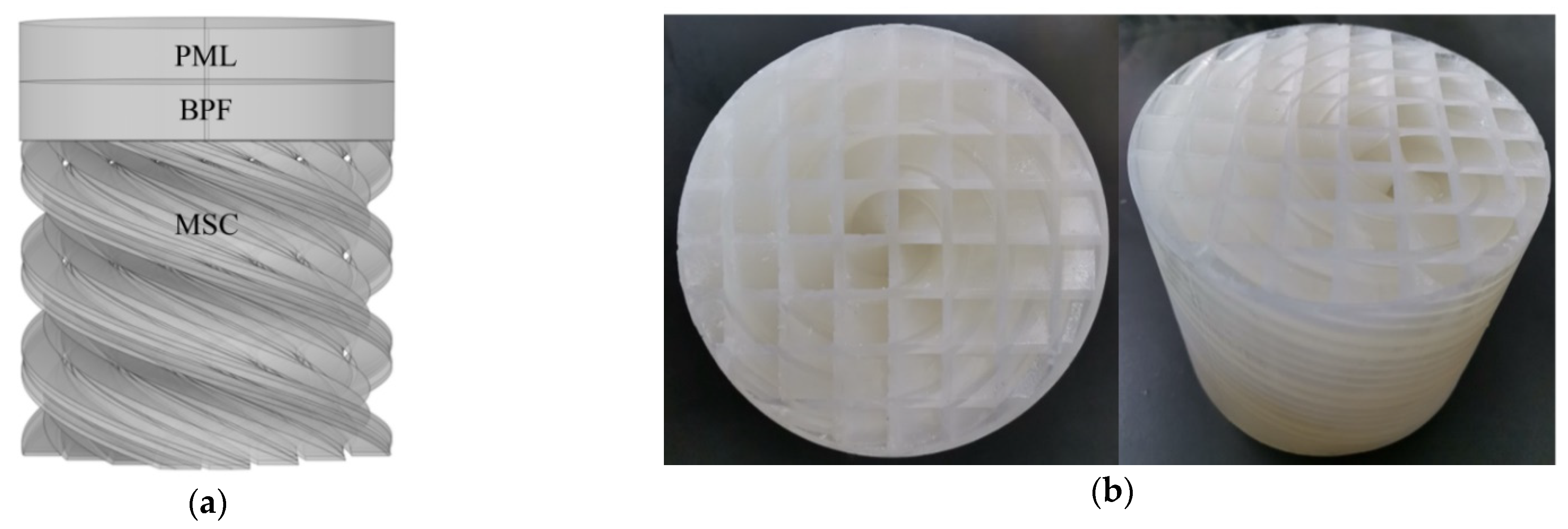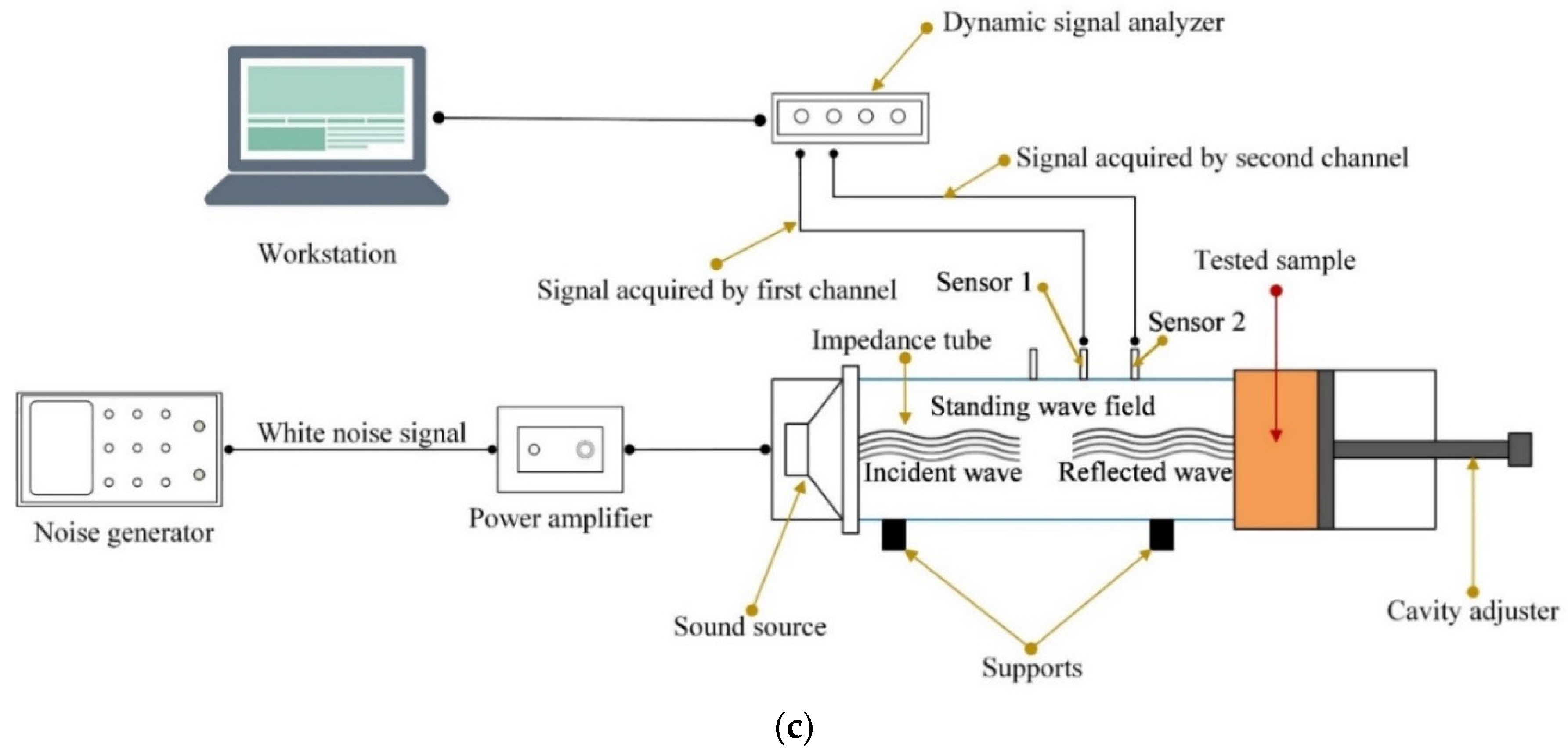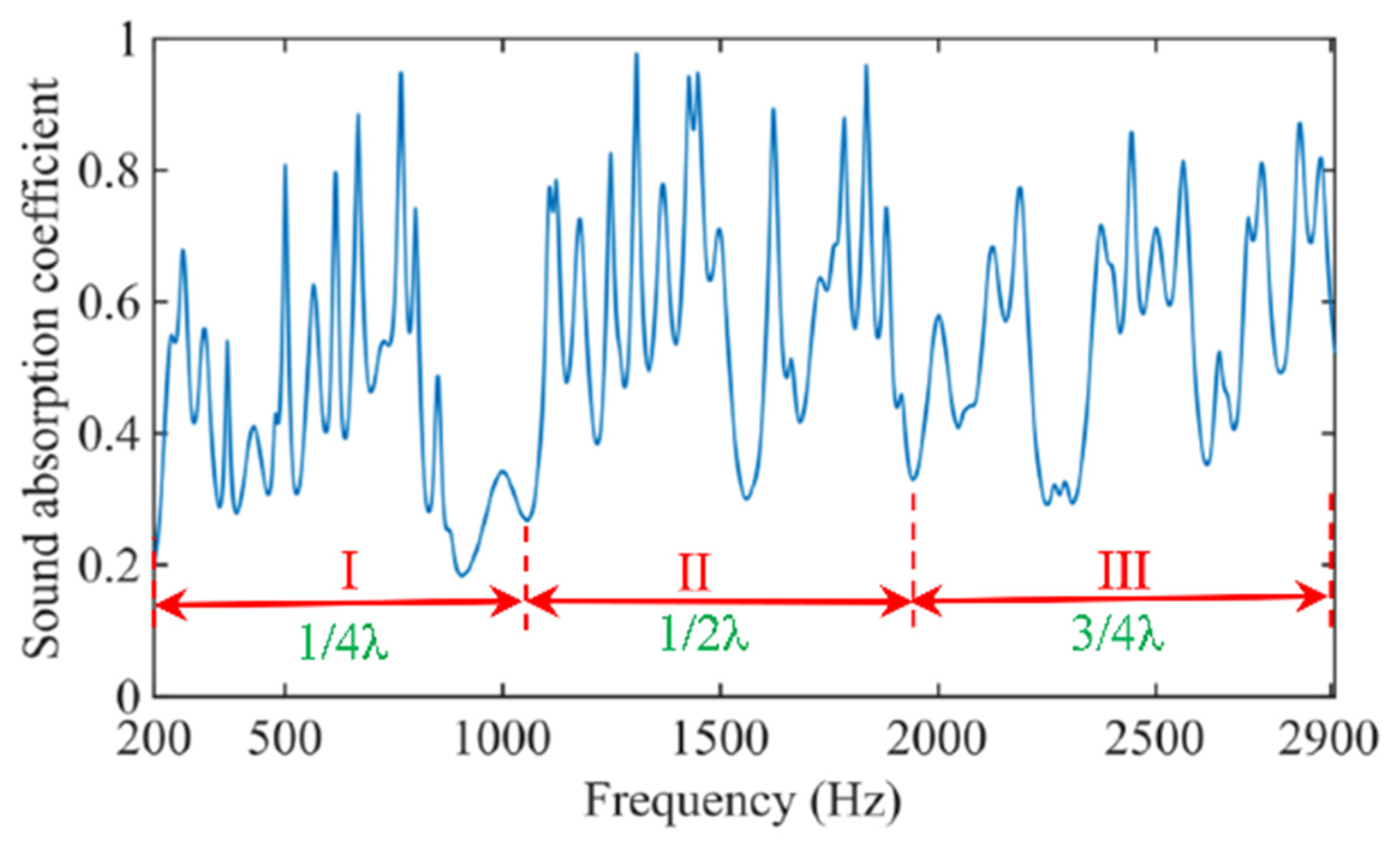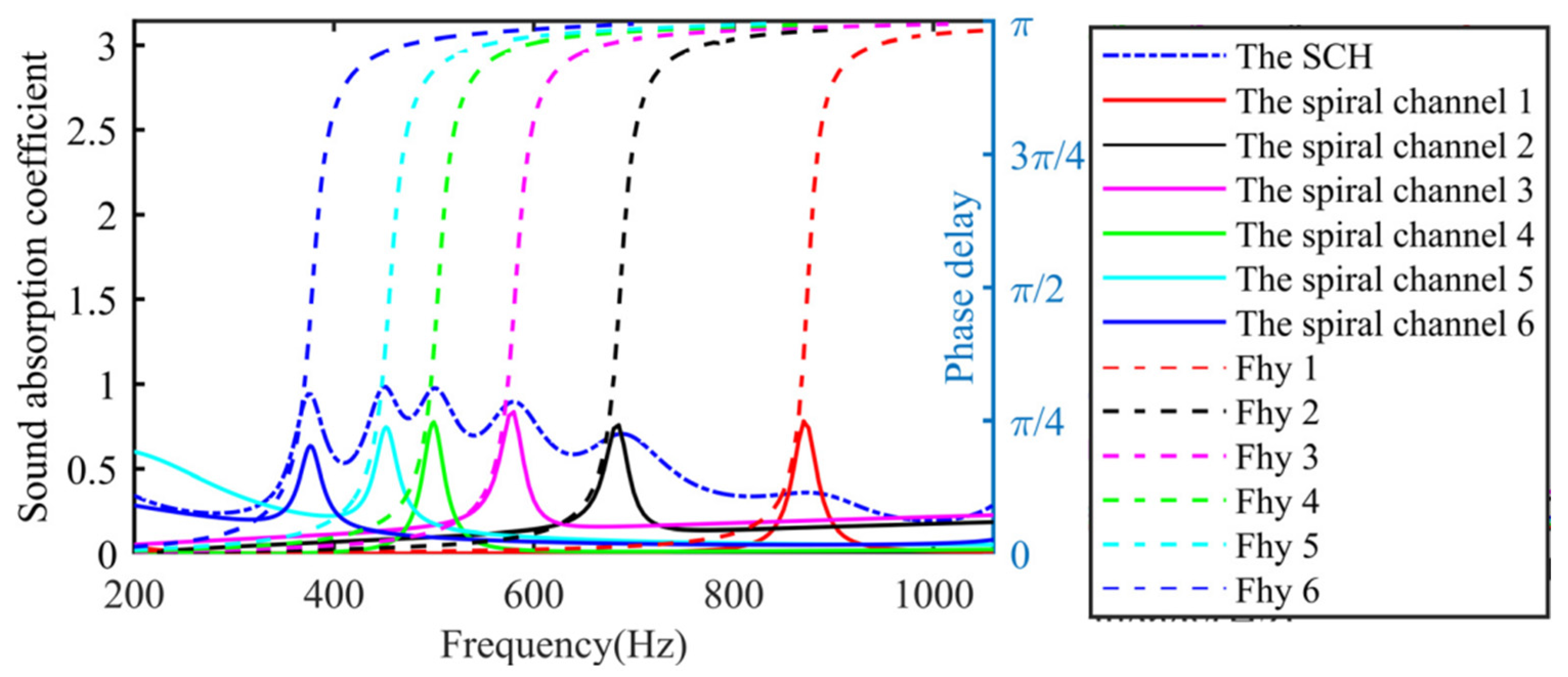Acoustic Metamaterials for Low-Frequency Noise Reduction Based on Parallel Connection of Multiple Spiral Chambers
Abstract
:1. Introduction
2. Materials and Design
2.1. Structural Design
2.2. Theoretical Modeling
2.3. Theoretical Analysis and Experimental Validation
2.3.1. Finite Element Simulation Analysis
2.3.2. Sample Preparation by Additive Manufacturing Technology
2.3.3. Experimental Verification by Standing Wave Tube
3. Results and Discussion
3.1. Theoretical Analysis Results
3.2. Finite Element Simulation Results
3.3. Experimental Results
4. Conclusions
- (1)
- The FP channel is curled to the spiral chamber through the ingenious structural design, which can significantly reduce the occupied space of the MSC-AM absorber and effectively realize a broadband sound absorption in the low-frequency range. In this study, six series of spiral chambers, with sequential lengths of 95.99 mm, 138.72 mm, 152.27 mm, 191.19 mm, 201.23 mm and 247.25 mm, are compactly arranged in a cylinder with a diameter of 100 mm and thickness of 80 mm, which form the proposed MSC-AM.
- (2)
- A theoretical model for sound-absorption performance of the MSC-AM is built according to the derivation of its acoustic impedance, which preliminarily proves that the MSC-AM can achieve broadband sound absorption in the low-frequency range. Moreover, the sound-absorption mechanism of MSC-AM is revealed through the finite element simulation, which indicates that under stimulation of the external sound field, perfect absorption is realized by the strong resonance within a certain frequency for each group of FP spiral chambers with the same length in the MSC-AM. Furthermore, parallel connections of the multiple spiral chambers with various lengths form the MSC-AM can obtain the broad bandwidth through the coupling of multiple absorption peaks.
- (3)
- The experimental sample of MSC-AM is prepared by an LFS 3D printer based on additive manufacturing, and its actual sound-absorption coefficients are measured by the AWA6290T standing wave tube tester. The experimental results indicate that the actual sound-absorption coefficients of the MSC-AM exceed 0.8 with a bandwidth of Δf1 = 320 Hz in the 360–680 Hz range, which certifies that it can obtain excellent sound-absorption performance in the low-frequency range. Meanwhile, in the bandwidth of Δf2 = 1250 Hz in the 350–1600 Hz range, its sound absorption coefficients are larger than 0.5, which proves that it can achieve broadband sound absorption in the low–middle frequency region.
Author Contributions
Funding
Institutional Review Board Statement
Informed Consent Statement
Data Availability Statement
Conflicts of Interest
References
- Van Kempen, E.; Casas, M.; Pershagen, G.; Foraster, M. WHO Environmental Noise Guidelines for the European Region: A Systematic Review on Environmental Noise and Cardiovascular and Metabolic Effects: A Summary. Int. J. Environ. Res. Public Health 2018, 15, 379. [Google Scholar] [CrossRef] [PubMed] [Green Version]
- Basner, M.; Babisch, W.; Davis, A.; Brink, M.; Clark, C.; Janssen, S.; Stansfeld, S. Auditory and non-auditory effects of noise on health. Lancet 2014, 383, 1325–1332. [Google Scholar] [CrossRef] [Green Version]
- Münzel, T.; Gori, T.; Babisch, W.; Basner, M. Cardiovascular effects of environmental noise exposure. Eur. Heart J. 2014, 35, 829–836. [Google Scholar] [CrossRef] [PubMed] [Green Version]
- Hume, K.I.; Brink, M.; Basner, M. Effects of environmental noise on sleep. Noise Health 2012, 14, 297–302. [Google Scholar] [CrossRef]
- Elmenhorst, E.-M.; Pennig, S.; Rolny, V.; Quehl, J.; Mueller, U.; Maaß, H.; Basner, M. Examining nocturnal railway noise and aircraft noise in the field: Sleep, psychomotor performance, and annoyance. Sci. Total Environ. 2012, 424, 48–56. [Google Scholar] [CrossRef]
- Moussa, T.; Maalouf, C.; Bliard, C.; Abbes, B.; Badouard, C.; Lachi, M.; Sodré, S.D.S.V.; Bufalino, L.; Bogard, F.; Beaumont, F.; et al. Spent Coffee Grounds as Building Material for Non-Load-Bearing Structures. Materials 2022, 15, 1689. [Google Scholar] [CrossRef]
- Tao, Y.P.; Ren, M.S.; Zhang, H.; Peijs, T. Recent progress in acoustic materials and noise control strategies—A review. Appl. Mater. Today 2021, 24, 101141. [Google Scholar] [CrossRef]
- Yan, C.; Luo, Y.J.; Zhang, W.G.; Zhu, Z.F.; Li, P.Y.; Li, N.; Chen, Y.F.; Jin, T. Preparation of a novel melamine foam structure and properties. J. Appl. Polym. Sci. 2021, 139, e51992. [Google Scholar] [CrossRef]
- Giusca, C.L.; Claverley, J.D.; Sun, W.J.; Leach, R.K.; Helmli, F.; Chavigner, M.P.J. Practical estimation of measurement noise and flatness deviation on focus variation microscopes. CIRP Ann.-Manuf. Technol. 2014, 63, 545–548. [Google Scholar] [CrossRef]
- Podulka, P. Suppression of the High-Frequency Errors in Surface Topography Measurements Based on Comparison of Various Spline Filtering Methods. Materials 2021, 14, 5096. [Google Scholar] [CrossRef]
- Ayton, L.J.; Peake, N. On high-frequency sound generated by gust–aerofoil interaction in shear flow. J. Fluid Mech. 2015, 766, 297–325. [Google Scholar] [CrossRef] [Green Version]
- Yang, Z.; Mei, J.; Yang, M.; Chan, N.H.; Sheng, P. Membrane-Type Acoustic Metamaterial with Negative Dynamic Mass. Phys. Rev. Lett. 2008, 101, 204301. [Google Scholar] [CrossRef] [PubMed]
- Ciaburro, G.; Parente, R.; Iannace, G.; Puyana-Romero, V. Design Optimization of Three-Layered Metamaterial Acoustic Absorbers Based on PVC Reused Membrane and Metal Washers. Sustainability 2022, 14, 4218. [Google Scholar] [CrossRef]
- Li, J.; Shi, Y.; Jiang, R.; Zhang, Z.; Huang, Q. Acoustic Insulation Mechanism of Membrane-Type Acoustic Metamaterials Loaded with Arbitrarily Shaped Mass Blocks of Variable Surface Density. Materials 2022, 15, 1556. [Google Scholar] [CrossRef]
- Mo, J.; Peng, Z.; Wang, X. Achieving Enhanced Sound Insulation through Micromembranes-Type Acoustic Metamaterials. Appl. Sci. 2022, 12, 1950. [Google Scholar] [CrossRef]
- Lu, K.; Wu, J.H.; Guan, D.; Gao, N.; Jing, L. A lightweight low-frequency sound insulation membrane-type acoustic metamaterial. AIP Adv. 2016, 6, 025116. [Google Scholar] [CrossRef] [Green Version]
- Jiménez, N.; Romero-García, V.; Pagneux, V.; Groby, J.-P. Quasiperfect absorption by subwavelength acoustic panels in transmission using accumulation of resonances due to slow sound. Phys. Rev. B 2017, 95, 014205. [Google Scholar] [CrossRef] [Green Version]
- Huang, S.B.; Fang, X.S.; Wang, X.; Assouar, B.; Cheng, Q.; Li, Y. Acoustic perfect absorbers via Helmholtz resonators with embedded apertures. J. Acoust. Soc. Am. 2019, 145, 254–262. [Google Scholar] [CrossRef]
- Duan, M.Y.; Yu, C.L.; Xu, Z.M.; Xin, F.X.; Lu, T.J. Acoustic impedance regulation of Helmholtz resonators for perfect sound absorption via roughened embedded necks. Appl. Phys. Lett. 2020, 117, 151904. [Google Scholar] [CrossRef]
- Cai, X.B.; Guo, Q.Q.; Hu, G.K.; Yang, J. Ultrathin low-frequency sound absorbing panels based on coplanar spiral tubes or coplanar Helmholtz resonators. Appl. Phys. Lett. 2014, 105, 121901. [Google Scholar] [CrossRef] [Green Version]
- Li, Y.; Assouar, B.M. Acoustic metasurface-based perfect absorber with deep subwavelength thickness. Appl. Phys. Lett. 2016, 108, 063502. [Google Scholar] [CrossRef]
- Almeida, G.D.N.; Vergara, E.F.; Barbosa, L.R.; Brum, R. Low-frequency sound absorption of a metamaterial with symmetrical-coiled-up spaces. Appl. Acoust. 2020, 172, 107593. [Google Scholar] [CrossRef]
- Liu, L.; Chang, H.; Zhang, C.; Hu, X. Single-channel labyrinthine metasurfaces as perfect sound absorbers with tunable bandwidth. Appl. Phys. Lett. 2017, 111, 083503. [Google Scholar] [CrossRef]
- Yang, M.; Sheng, P. Sound Absorption Structures: From Porous Media to Acoustic Metamaterials. Annu. Rev. Mater. Sci. 2017, 47, 83–114. [Google Scholar] [CrossRef]
- Guo, J.W.; Fang, Y.; Jiang, Z.Y.; Zhang, X. An investigation on noise attenuation by acoustic liner constructed by Helmholtz resonators with extended necks. J. Acoust. Soc. Am. 2021, 149, 70–81. [Google Scholar] [CrossRef] [PubMed]
- Liu, C.R.; Wu, J.H.; Ma, F.; Chen, X.; Yang, Z. A thin multi-order Helmholtz metamaterial with perfect broadband acoustic absorption. Appl. Phys. Express 2019, 12, 084002. [Google Scholar] [CrossRef]
- Sharma, A.K.; Kosta, M.; Shmuel, G.; Amir, O. Gradient-based topology optimization of soft dielectrics as tunable phononic crystals. Compos. Struct. 2021, 280, 114846. [Google Scholar] [CrossRef]
- Sharma, A.K.; Joglekar, M.M.; Joglekar, D.M.; Alam, Z. Topology optimization of soft compressible phononic laminates for widening the mechanically tunable band gaps. Compos. Struct. 2022, 289, 115389. [Google Scholar] [CrossRef]
- Zhang, C.; Hu, X.H. Three-Dimensional Single-Port Labyrinthine Acoustic Metamaterial: Perfect Absorption with Large Bandwidth and Tunability. Phys. Rev. Appl. 2016, 6, 064025. [Google Scholar] [CrossRef] [Green Version]
- Yang, M.; Chen, S.Y.; Fuab, C.X.; Sheng, P. Optimal sound-absorbing structures. Mater. Horiz. 2017, 4, 673–680. [Google Scholar] [CrossRef] [Green Version]
- Han, Y.; Wang, X.P.; Xie, G.L.; Tang, X.; Chen, T.N. Low-frequency sound-absorbing metasurface with a channel of nonuniform cross section. J. Appl. Phys. 2020, 127, 064902. [Google Scholar] [CrossRef]
- Hedayati, R.; Bodaghi, M. Acoustic Metamaterials and Acoustic Foams: Recent Advances. Appl. Sci. 2022, 12, 3096. [Google Scholar] [CrossRef]
- Gao, H.; Yan, Q.; Liu, X.; Zhang, Y.; Sun, Y.; Ding, Q.; Wang, L.; Xu, J.; Yan, H. Low-Frequency Bandgaps of the Lightweight Single-Phase Acoustic Metamaterials with Locally Resonant Archimedean Spirals. Materials 2022, 15, 373. [Google Scholar] [CrossRef] [PubMed]
- Wang, Y.; Zhao, H.G.; Yang, H.B.; Zhong, J.; Zhao, D.; Lu, Z.L.; Wen, J.H. A tunable sound-absorbing metamaterial based on coiled-up space. J. Appl. Phys. 2018, 123, 185109. [Google Scholar] [CrossRef]
- Jiménez, N.; Romero-García, V.; Pagneux, V.; Groby, J.-P. Rainbow-trapping absorbers: Broadband, perfect and asymmetric sound absorption by subwavelength panels for transmission problems. Sci. Rep. 2017, 7, 13595. [Google Scholar] [CrossRef]
- Tang, Y.F.; Ren, S.W.; Meng, H.; Xin, F.X.; Huang, L.X.; Chen, T.N.; Zhang, C.Z.; Lu, T.J. Hybrid acoustic metamaterial as super absorber for broadband low-frequency sound. Sci. Rep. 2017, 7, 43340. [Google Scholar] [CrossRef] [Green Version]
- Duan, H.Q.; Shen, X.M.; Wang, E.S.; Yang, F.; Zhang, X.N.; Yin, Q. Acoustic multi-layer Helmholtz resonance metamaterials with multiple adjustable absorption peaks. Appl. Phys. Lett. 2021, 118, 241904. [Google Scholar] [CrossRef]
- Peng, X.Y.; Ji, J.; Jing, Y. Composite honeycomb metasurface panel for broadband sound absorption. J. Acoust. Soc. Am. 2018, 144, EL255–EL261. [Google Scholar] [CrossRef] [Green Version]
- Zhang, X.H.; Qu, Z.G.; Wang, H. Engineering Acoustic Metamaterials for Sound Absorption: From Uniform to Gradient Structures. iScience 2020, 23, 101110. [Google Scholar] [CrossRef]
- Liang, Z.X.; Li, J.S. Extreme Acoustic Metamaterial by Coiling Up Space. Phys. Rev. Lett. 2012, 108, 114301. [Google Scholar] [CrossRef]
- Liang, Z.X.; Feng, T.H.; Lok, S.; Liu, F.; Ng, K.B.; Chan, C.H.; Wang, J.J.; Han, S.; Lee, S.; Li, J.S. Space-coiling metamaterials with double negativity and conical dispersion. Sci. Rep. 2013, 3, 1614. [Google Scholar] [CrossRef] [PubMed] [Green Version]
- Xie, Y.; Popa, B.-I.; Zigoneanu, L.; Cummer, S.A. Measurement of a Broadband Negative Index with Space-Coiling Acoustic Metamaterials. Phys. Rev. Lett. 2013, 110, 175501. [Google Scholar] [CrossRef] [PubMed]
- Tijdeman, H. On the propagation of sound waves in cylindrical tubes. J. Sound Vib. 1975, 39, 1–33. [Google Scholar] [CrossRef]
- Askari, M.; Hutchins, D.A.; Thomas, P.J.; Astolfi, L.; Watson, R.L.; Abdi, M.; Ricci, M.; Laureti, S.; Nie, L.; Freear, S.; et al. Additive manufacturing of metamaterials: A review. Addit. Manuf. 2021, 36, 101562. [Google Scholar] [CrossRef]
- Xu, Z.B.; Wang, B.C.; Zhang, S.M.; Chen, R.J. Design and acoustical performance investigation of sound absorption structure based on plastic micro-capillary films. Appl. Acoust. 2015, 89, 152–158. [Google Scholar] [CrossRef]
- Liang, L.S.; Liu, S.W.; Zhao, J.X.; Liu, M.B.; Sun, Q. Investigation of Sound Absorption Feature of Closed-Cell Aluminum Foams Combined with Porous Materials. Nanosci. Nanotechnol. Lett. 2017, 9, 392–397. [Google Scholar] [CrossRef]
- Okuzono, T.; Sakagami, K. A finite-element formulation for room acoustics simulation with microperforated panel sound absorbing structures: Verification with electro-acoustical equivalent circuit theory and wave theory. Appl. Acoust. 2015, 95, 20–26. [Google Scholar] [CrossRef] [Green Version]
- Okuzono, T.; Sakagami, K. A frequency domain finite element solver for acoustic simulations of 3D rooms with microperforated panel absorbers. Appl. Acoust. 2018, 129, 1–12. [Google Scholar] [CrossRef] [Green Version]
- Stinson, M.R. The propagation of plane sound waves in narrow and wide circular tubes, and generalization to uniform tubes of arbitrary cross-sectional shape. J. Acoust. Soc. Am. 1991, 89, 550–558. [Google Scholar] [CrossRef]
- Scheichl, S. On the calculation of the transmission line parameters for long tubes using the method of multiple scales. J. Acoust. Soc. Am. 2004, 115, 534–555. [Google Scholar] [CrossRef]
- Yang, X.; Peng, K.; Shen, X.; Zhang, X.; Bai, P.; Xu, P. Geometrical and Dimensional Optimization of Sound Absorbing Porous Copper with Cavity. Mater. Des. 2017, 131, 297–306. [Google Scholar] [CrossRef]








| Parameters | Symbol | Unit | Values |
|---|---|---|---|
| Acoustic velocity of the air | m/s | 343 | |
| Density of the air | 1.21 | ||
| Standard atmospheric pressure | Pa | 1.01325 × 105 | |
| dynamic viscosity coefficient | 1.8 × 10−5 | ||
| thermal conductivity | 0.0258 | ||
| specific heat capacity at the constant volume | 718 | ||
| specific heat ratio of the air | - | 1.4 |
Publisher’s Note: MDPI stays neutral with regard to jurisdictional claims in published maps and institutional affiliations. |
© 2022 by the authors. Licensee MDPI, Basel, Switzerland. This article is an open access article distributed under the terms and conditions of the Creative Commons Attribution (CC BY) license (https://creativecommons.org/licenses/by/4.0/).
Share and Cite
Duan, H.; Yang, F.; Shen, X.; Yin, Q.; Wang, E.; Zhang, X.; Yang, X.; Shen, C.; Peng, W. Acoustic Metamaterials for Low-Frequency Noise Reduction Based on Parallel Connection of Multiple Spiral Chambers. Materials 2022, 15, 3882. https://doi.org/10.3390/ma15113882
Duan H, Yang F, Shen X, Yin Q, Wang E, Zhang X, Yang X, Shen C, Peng W. Acoustic Metamaterials for Low-Frequency Noise Reduction Based on Parallel Connection of Multiple Spiral Chambers. Materials. 2022; 15(11):3882. https://doi.org/10.3390/ma15113882
Chicago/Turabian StyleDuan, Haiqin, Fei Yang, Xinmin Shen, Qin Yin, Enshuai Wang, Xiaonan Zhang, Xiaocui Yang, Cheng Shen, and Wenqiang Peng. 2022. "Acoustic Metamaterials for Low-Frequency Noise Reduction Based on Parallel Connection of Multiple Spiral Chambers" Materials 15, no. 11: 3882. https://doi.org/10.3390/ma15113882
APA StyleDuan, H., Yang, F., Shen, X., Yin, Q., Wang, E., Zhang, X., Yang, X., Shen, C., & Peng, W. (2022). Acoustic Metamaterials for Low-Frequency Noise Reduction Based on Parallel Connection of Multiple Spiral Chambers. Materials, 15(11), 3882. https://doi.org/10.3390/ma15113882









